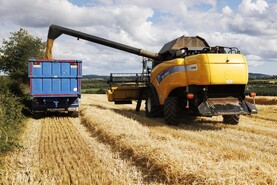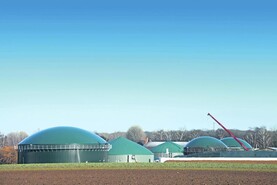Speaking at the Irish Farmers Journal open day at the Tullamore Farm last week, Minister for Agriculture Charlie McConalogue said that the “seven-month winter we just had has to be the benchmark for the future” and he emphasised the need for the agricultural sector to have the level of fodder available to meet the needs of housing cattle from October to April.
While there is some context to the minister’s remarks as he remained under pressure to justify his surprising – and subsequently reversed – decision on straw incorporation, taking them at face value could lead to some serious planning changes on many farms.
Long winters hit farm viability in two obvious ways. The longer cattle spend in the shed, the more fodder they will need.
The shorter the growing season – growth is back 10% this year – the less fodder there will be for feeding those cattle.
This suggests that Ireland will, if we use last winter as a benchmark, almost inevitably have fewer cattle in the country.
But before we get too far ahead of ourselves, let’s look at what the data tells us.
Looking at rainfall and cattle numbers between 1990 and 2010 (Figure 1), we can see that increases and decreases in total annual rainfall in Ireland did not have much of a correlation with the number of cattle in the country the following year.
In the 12 years which were wetter than the previous year, there was a drop in cattle numbers in the subsequent year on only five occasions.
However, if we narrow down our search to only look at years in which a fodder crisis occurred, a different picture emerges. The most notable fodder crises in this country over the past 30 years occurred in 1998, 2013 and 2018. There was a large drop in cattle numbers in both 1999 and 2019, with a slight increase occurring in 2014 (Figure 2).
The data suggests that normal year-to-year variations in rainfall amounts have little direct effect on livestock numbers, while years where there is an actual fodder crisis do generally lead to a drop in livestock numbers the following year.
The thing about fodder crises is that, until now, they have been occasional events. There have been just three over the last 30 years. They are damaging for farm incomes and livestock numbers, but they also can be recovered over subsequent years when livestock and fodder levels can be rebuilt.
Going back to the minister’s comments, we may be looking at a new scenario where there could be two or more years in a row with long winters, reduced grass growth and a shortage of feed.
In order to try to figure out how likely this scenario is, we again can look at the data.
Higher temperatures
Climate projections from Met Éireann suggest that Ireland will see higher temperatures over the coming decades.
With 19 of the last 20 years having higher temperatures than the long-term average, there is certainly a trend already in place.
The 30 years to 2020 saw average monthly temperatures 0.70C above the previous 30-year average (Figure 3).
The modelling from Met Éireann for the coming decades suggest this trend will remain in place, with longer dry, hot periods during the summer months.
On rainfall, the projection suggests that there will be significant decreases in rainfall in the spring and summer months, with up to 20% less precipitation during those seasons.
However, the projections also suggest that there will be an increase in heavy rainfall events during the autumn and winter months.
Long, dry spells in the summer months and wet autumns and winters would certainly increase pressure on fodder as drought during growing periods would reduce yields, while wet autumns could lead to earlier housing of animals.
The one bright spot in the projections is for warmer, drier springs which may facilitate the earlier turnout of cattle.
Changing weather patterns must be met with economic and environmental plans
Sustainability is a word that is often used in the context of reducing emissions of greenhouse gases.
But, for the Irish agricultural sector, sustainability is also critical in the context of having a profitable industry that can be maintained over the longer-term.
Changes in the climate, which we are already experiencing, have meant fodder has had to occasionally be imported to this country to meet the needs of farmers. If it were to become more common in future years, then that economic sustainability could come into question.
The minister’s comments about a seven-month winter may be a little extreme, but the data does suggest increasing risks to fodder levels in future.
It is clear that Irish farmers will have to get better at dealing with the effects of changing weather patterns in future, as well as continuing to do what they can on being more environmentally sustainable.
Minister said seven-month winter should be “benchmark” for future.Rainfall variations have little direct impact on cattle numbers.Temperature and rainfall have increased in recent decades.Future projections suggest drier summers and wetter autumns.Farms need to be economically, as well as environmentally, sustainable.
Speaking at the Irish Farmers Journal open day at the Tullamore Farm last week, Minister for Agriculture Charlie McConalogue said that the “seven-month winter we just had has to be the benchmark for the future” and he emphasised the need for the agricultural sector to have the level of fodder available to meet the needs of housing cattle from October to April.
While there is some context to the minister’s remarks as he remained under pressure to justify his surprising – and subsequently reversed – decision on straw incorporation, taking them at face value could lead to some serious planning changes on many farms.
Long winters hit farm viability in two obvious ways. The longer cattle spend in the shed, the more fodder they will need.
The shorter the growing season – growth is back 10% this year – the less fodder there will be for feeding those cattle.
This suggests that Ireland will, if we use last winter as a benchmark, almost inevitably have fewer cattle in the country.
But before we get too far ahead of ourselves, let’s look at what the data tells us.
Looking at rainfall and cattle numbers between 1990 and 2010 (Figure 1), we can see that increases and decreases in total annual rainfall in Ireland did not have much of a correlation with the number of cattle in the country the following year.
In the 12 years which were wetter than the previous year, there was a drop in cattle numbers in the subsequent year on only five occasions.
However, if we narrow down our search to only look at years in which a fodder crisis occurred, a different picture emerges. The most notable fodder crises in this country over the past 30 years occurred in 1998, 2013 and 2018. There was a large drop in cattle numbers in both 1999 and 2019, with a slight increase occurring in 2014 (Figure 2).
The data suggests that normal year-to-year variations in rainfall amounts have little direct effect on livestock numbers, while years where there is an actual fodder crisis do generally lead to a drop in livestock numbers the following year.
The thing about fodder crises is that, until now, they have been occasional events. There have been just three over the last 30 years. They are damaging for farm incomes and livestock numbers, but they also can be recovered over subsequent years when livestock and fodder levels can be rebuilt.
Going back to the minister’s comments, we may be looking at a new scenario where there could be two or more years in a row with long winters, reduced grass growth and a shortage of feed.
In order to try to figure out how likely this scenario is, we again can look at the data.
Higher temperatures
Climate projections from Met Éireann suggest that Ireland will see higher temperatures over the coming decades.
With 19 of the last 20 years having higher temperatures than the long-term average, there is certainly a trend already in place.
The 30 years to 2020 saw average monthly temperatures 0.70C above the previous 30-year average (Figure 3).
The modelling from Met Éireann for the coming decades suggest this trend will remain in place, with longer dry, hot periods during the summer months.
On rainfall, the projection suggests that there will be significant decreases in rainfall in the spring and summer months, with up to 20% less precipitation during those seasons.
However, the projections also suggest that there will be an increase in heavy rainfall events during the autumn and winter months.
Long, dry spells in the summer months and wet autumns and winters would certainly increase pressure on fodder as drought during growing periods would reduce yields, while wet autumns could lead to earlier housing of animals.
The one bright spot in the projections is for warmer, drier springs which may facilitate the earlier turnout of cattle.
Changing weather patterns must be met with economic and environmental plans
Sustainability is a word that is often used in the context of reducing emissions of greenhouse gases.
But, for the Irish agricultural sector, sustainability is also critical in the context of having a profitable industry that can be maintained over the longer-term.
Changes in the climate, which we are already experiencing, have meant fodder has had to occasionally be imported to this country to meet the needs of farmers. If it were to become more common in future years, then that economic sustainability could come into question.
The minister’s comments about a seven-month winter may be a little extreme, but the data does suggest increasing risks to fodder levels in future.
It is clear that Irish farmers will have to get better at dealing with the effects of changing weather patterns in future, as well as continuing to do what they can on being more environmentally sustainable.
Minister said seven-month winter should be “benchmark” for future.Rainfall variations have little direct impact on cattle numbers.Temperature and rainfall have increased in recent decades.Future projections suggest drier summers and wetter autumns.Farms need to be economically, as well as environmentally, sustainable. 





 This is a subscriber-only article
This is a subscriber-only article










SHARING OPTIONS: